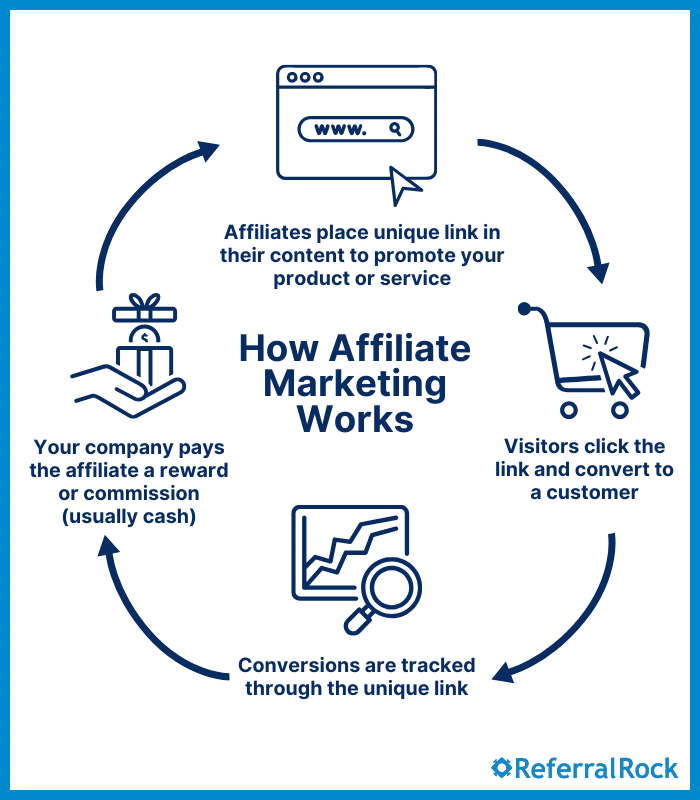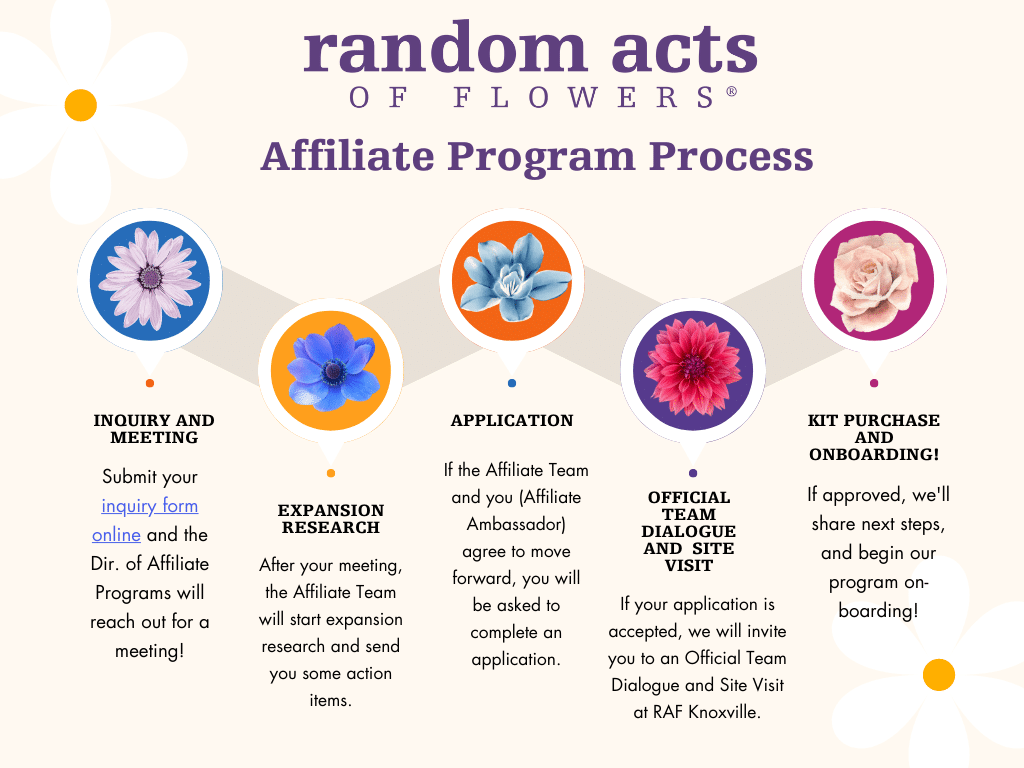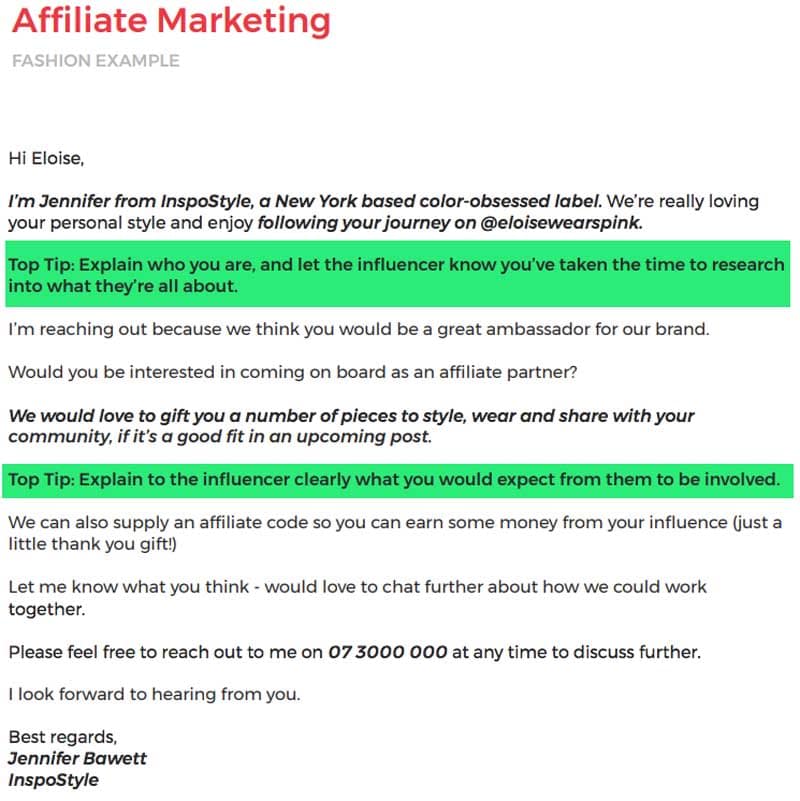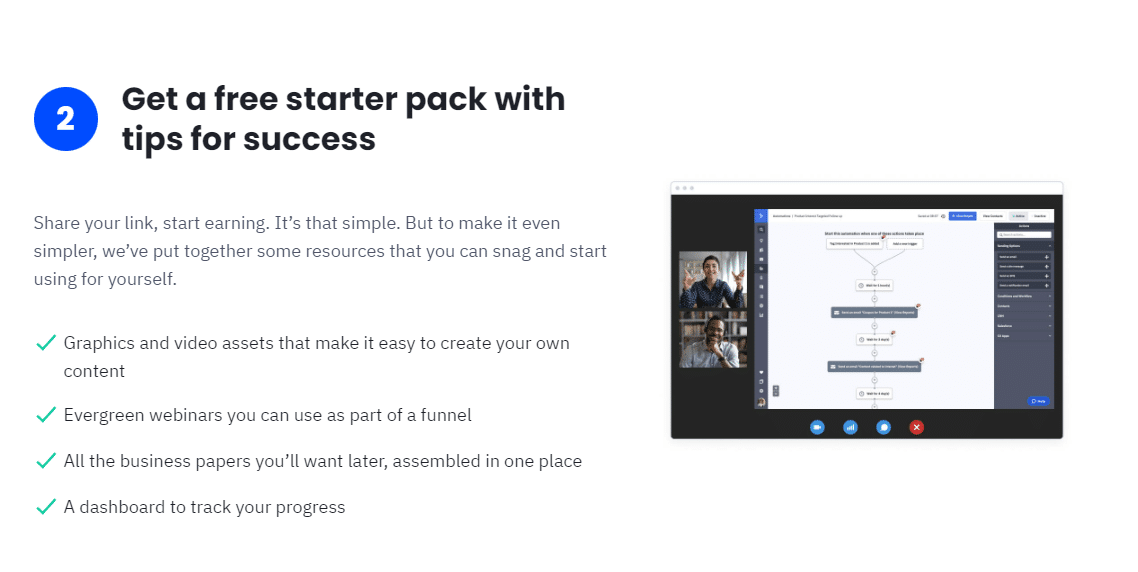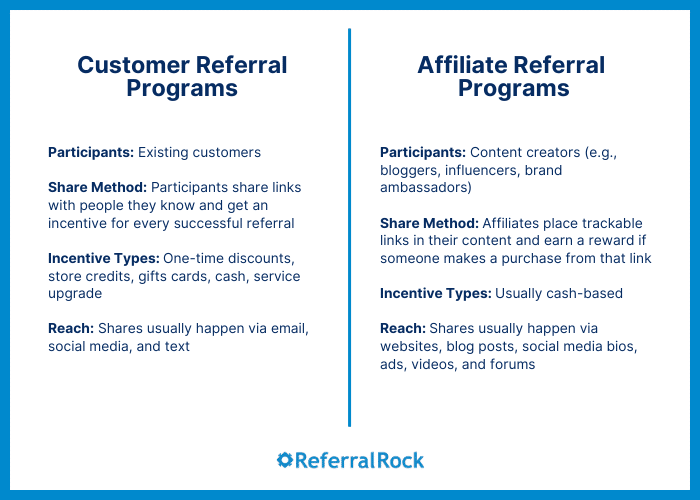Starting and running a successful affiliate program can feel like a huge project to tackle: you’ll need to find and train the right affiliates, decide on the right commission, promote the program, and have a plan to track their success. You’ll also need to make sure affiliates follow your program’s rules.
Want to learn how to start an affiliate program for your business (and run it successfully after launch)? This guide covers everything beginners need.
By following these eight easy steps, you’ll learn how to set up the best affiliate program (using affiliate marketing software to launch and scale), and equip it for success.
What is an affiliate program?
An affiliate marketing program encourages content creators to promote and link to your brand’s website, and rewards them with an affiliate commission whenever they help you make a sale.
An affiliate program involves recruiting content creators and entrepreneurs, such as bloggers, social media personalities, or niche experts, to promote your brand on their websites or social accounts. These creators will place affiliate links – unique, trackable links that direct readers to your own website – within their content. Then, you’ll pay these affiliates a commission every time someone makes a purchase via their affiliate link.
Affiliates earn passive income, and you’ve got trusted voices promoting your products. It’s a win-win!
Is an affiliate program right for your online business?
Whether you sell physical products or a digital subscription service, there’s a good chance that starting an affiliate marketing program will work for you. Still, your brand must meet several standards for an affiliate program to work.
Here are a few things to keep in mind before you start affiliate marketing:
- An affiliate program will work well if you want others to promote your business on their own channels and drive traffic directly to your website.
- Affiliates won’t resell your products for you. Instead, they’ll recommend and link to products that you sell within your own online store.
- You must be willing to pay affiliates with a cash commission (or store credit) every time they help you make a sale.
- It’s best if your product or service appeals to a wide audience.
- You need to have access to good-fit affiliates – creators whose niche or target audience matches yours.
Affiliate marketing campaigns work best if your company has high customer retention rates.
- If a customer brings in continued profits for your business, you’ll more easily be able to afford the repeated commissions.
- Plus, since you won’t spend as much money on customer acquisition costs, you’ll be able to offer higher commission payouts, and entice higher-quality affiliates to join your program.
Affiliate programs work especially well for businesses with higher profit margins.
Although these programs can work for nearly any industry, ecommerce retailers and online subscription businesses (including SaaS businesses) use affiliates most often.
That’s because affiliate marketing tends to work better for physical and digital products with high profit margins (like software, online courses, and hosting services), as opposed to service-based businesses. And if your product involves a subscription or is purchased regularly, even better.
In our own Referral Rock survey, 56 marketers shared that affiliate marketing works best for the following types of businesses:
- Ecommerce (80%)
- Beauty (77%)
- Apparel (68%)
- Tech (68%)
- Health (61%)
- Subscription services (61%)
* If you’re a subscription-based company, it’s your choice whether to credit affiliates every time a customer they brought in renews their subscription.
How to start an affiliate program in 8 steps
Now that you’ve determined an affiliate program is right for you, you know how it works, and you’ve seen some of the benefits, follow this step-by-step guide to launch a successful affiliate program.
Here’s how to start an affiliate program:
Step 1: Set goals for your program
Like with all marketing programs, you’ll need to start by setting goals for your affiliate program.
First, you’ll need to establish the audience you want to reach.
- What types of customers do you want to bring in through your affiliate program?
- What types of affiliates will help you do so?
Next, set a few top measurable goals, or KPIs, for your program. This will help you know whether your program is successful. KPIs must be SMART: specific, measurable, attainable, relevant, and time-bound.
- Your main goal will be the amount of revenue you’d like affiliates to bring in per month, per quarter or per year.
- Set goals for conversion rates: How often do you want people who click on affiliate links to make a purchase?
- Consider setting a goal for the average order value (AOV) driven by affiliates.
- Also, set goals for the numbers of unique affiliate sales in a given time period.
- You can also set goals for the impressions, clicks, and leads you’d like affiliates to bring in within these timeframes.
Sales are most important, of course, but these other metrics will also be helpful in measuring your affiliate program success.
Step 2: Analyze your competitors’ affiliate programs
You’ve probably done a general analysis to determine your business strengths and weaknesses versus those of your competitors. Now, it’s time to look into your competitor’s affiliate programs.
Even before designing your own, a detailed analysis of the available affiliate programs will let you know where you stand, and allow you to position your program competitively. After all, you’re also competing for affiliates.
Here’s how to run an affiliate program competitive analysis:
1. Find at least two competitors with affiliate programs. It also helps to find at least one business you don’t directly compete with, but that has the same audience as you (and that could potentially attract similar affiliates).
2. Look at how each competing program structures their affiliate commissions.
- What action triggers the payout of an affiliate commission (a sale, a lead generated, or something else)?
- Are affiliates paid a percentage of the sale as a commission, or a set amount for each action?
- Are affiliates paid in cash or in credits to use towards the brand’s products?
- How does each brand’s commission rate stack up? Does it seem high or low compared to other program commissions, and relative to the price of their products?
3. Determine how each brand finds their affiliates.
- Do they recruit affiliates on their own, or through an affiliate network?
- Are affiliates required to submit an application to be accepted?
- How rigorous is the application process?
4. What are the terms and conditions of each affiliate program?
- How does each brand allow affiliates to promote and post their affiliate link?
- What is an affiliate not allowed to do within a given program?
5. If you’re able to do some digging, try to find out other details about the competitor’s programs:
- What sort of training does each brand provide for affiliates, if any?
- What promotional and branding resources does each brand provide to affiliates (banners, creatives, free products)?
- Does the brand focus on affiliates who create certain content types, or who are most active on specific social media platforms?
- How often does each brand communicate with affiliates?
- How does a brand use affiliate tracking cookies? Do they use cookies to trace a sale back to an affiliate, even if someone doesn’t make a purchase right away? How long do the cookies stay active?
6. Finally, run a SWOT analysis.
- What are each program’s strengths and weaknesses?
- What opportunities could you take advantage of, because a competing program missed them?
- What threats might each competing program pose to your own affiliate program?
Step 3: Decide on the right affiliate commission
Use your competitive analysis findings to help you structure your own affiliate program. One of your most important design choices will be your commission structure, or the way you’ll pay your affiliates.
Even if you’ve seen other commission rules in competing programs, you should only compensate an affiliate if a sale is made via their affiliate link. (Don’t use a pay-per-click or pay-per-impression model, as this would leave you more vulnerable to fraud!)
First, decide whether you’ll pay a set amount for each sale, or a percentage of each sale affiliates make. You’ll also need to choose between paying in cash or store credit. Usually, a percentage commission, paid in cash, is most attractive to affiliates.
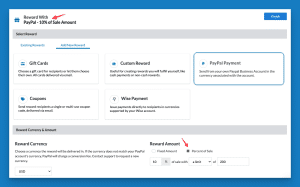
Next, decide on the exact affiliate commission rate you’ll offer. While you want this payout to be competitive compared to rival affiliate programs, remember: one-upping your competitors isn’t always the best strategy.
You also need to take care of your company’s own needs. Consider your customer acquisition costs, your retention rate, and your average customer lifetime value.
- How much does it usually cost to bring in a new customer?
- What percentage of customers do you retain in a given year?
- How much revenue can you rely on each customer to bring in?
Use all of this information to calculate a commission that will attract new affiliates, but will also be sustainable.
Referral Rock lets you set up higher-tiered commissions for affiliates as they meet sales goals, limited-time bonuses for your best performers, and more.
InkThemes advertises its commission rate to potential affiliates.
Step 4: Decide on other key aspects of your program structure
In addition to your commission, you’ll also need to decide on the following:
- How will you allow affiliates to promote and distribute their affiliate links? Which digital marketing channels can they use?
- How long will affiliate cookies be active (how long are affiliates eligible to earn a commission after someone clicks on their affiliate link)?
- What other terms and conditions will your affiliate program include?
- Will you give affiliates discount coupons for their audience, to help encourage more affiliate sales?
- How will you make your affiliate program stand out, compared to competitor programs?
- Will you designate or hire a dedicated affiliate manager for your program?
After all, this leads to more affiliate revenue (and more profits) for you. And if you’ve chosen a percentage commission payout, this leads to a higher commission for the affiliate – and higher affiliate income for your promoters.
Step 5: Start finding affiliates
How to launch an affiliate program, now that you’re ready with your own program structure? Your next step is to find affiliates. At this point, you’ll need to decide between using an existing network of affiliates and forming your own select affiliate network.
Will you use an existing affiliate marketer network?
An existing affiliate network can help you build up a base of representatives quickly, especially if they already have relationships with top affiliates in your niche. It can also nurture relationships with these affiliates for you, as networks usually handle affiliate management.
But affiliate networks also present a huge disadvantage. They charge their own commission (or finder’s fee, in a way) on top of the commission you pay affiliates directly. (Sometimes, this is up to 30% of the commission you charge.)
For example, if you pay affiliates $100,000 in a given year, an affiliate network might require you to pay them an additional $30,000 because it found the affiliates for you.
And even though affiliate networks track your affiliate performance, and automatically pay out affiliates, you won’t have direct control of your valuable affiliate data.
Will you form your own network of affiliates?
If you decide to form your own personal network of affiliates instead, you can still track affiliates efficiently, and compensate them automatically, with affiliate marketing software (also known as an affiliate marketing platform or affiliate management software).
Usually, affiliate software will cost much less per year than the fee you’d pay to tap into an existing affiliate network. Plus, software gives you full control over the data you need – and all other aspects of running a program. Thus, the right affiliate software offers plenty of advantages over using an existing affiliate network.
How do you form your own network of affiliates? Think about reputable websites, bloggers, and social media influencers that your potential customers follow and trust, that produce high-quality content, and that fit in the niche your brand occupies or appeal to the audience it serves.
Then, make a list of people behind those accounts, who you’d like to ask to be your affiliates. If they’re familiar with your product or service (and maybe already buy and love it), that’s even better. But it isn’t a requirement.
You could also place an open affiliate application on your website, promote the affiliate program, and let potential affiliates come to you. Screen them carefully, depending on your needs, and see how well their niche and audience match yours. Below is one example of an affiliate application and screening process.
Step 6: Screen potential affiliates, and recruit the best ones
Once you’ve found potential affiliates, it’s time to reach out to see if they’d like to join your affiliate team. Your goal is to find high-quality affiliates and avoid scammy ones. So, be sure to screen potential affiliates carefully – both manually and with business intelligence tools.
You’ll also need to decide on the number of affiliates you want to recruit. This will depend on the reach you want, and how exclusive you want your affiliate membership to be.
Here are several steps you should take when screening affiliates on your shortlist:
- Examine their websites, blogs, and/or social media profiles to see if their style and tone mesh well with your brand.
- Make sure they’re consistently active in creating content, and have high engagement from their readers or followers.
- Check their public profiles to make sure they haven’t engaged in unethical or questionable behavior, such as using spammy links.
- Ask potential affiliates for a concrete plan of how they would promote your brand if they’re selected.
- If possible, ask them about any previous experience they’ve had with affiliate marketing, including sales results they’ve delivered for other brands.
Once you’ve selected the affiliates you’d like to have in your program, reach out to them using a personalized affiliate recruitment message. This message should lay out how the program works, describe benefits to the affiliate (including how commissions work), and briefly summarize the affiliate’s responsibilities. The aim is to convince the affiliate to sign on, and kick off a healthy and warm relationship with the affiliate.
After affiliates decide to join your program, brief them on your program’s terms and conditions, and have them sign an affiliate partnership agreement to abide by these rules.
Learn all the essentials for creating an affiliate program agreement, and download our free affiliate agreement template.
Step 7: Train your affiliate team, and keep them in the loop
Train affiliates on brand and program fundamentals, give them their unique affiliate links, and go over best practices for placing and promoting these links. Also, supply affiliates with promotional resources, including branded banners, images of your products, or even videos.
Remember, though, that affiliate relationships are meant to be long-term, and need to be nurtured for the best results. Support doesn’t stop at training.
Send affiliate partners the latest updates and promotional announcements in a timely manner. This includes news about sales and offers, new products to promote, and any changes to the affiliate program. Scheduling a monthly webinar or Zoom meeting works well for this, as does posting updates in an exclusive Slack, LinkedIn, or Facebook group.
Make a plan to regularly check in on individual affiliates’ progress, whether that’s via email, direct messaging, your affiliates dashboard or even Zoom. Set times to check in, and stick to them.
And make sure they know how to reach you if they have questions about the program. Decide whether email, phone, an online form, direct messaging, or private forum works best for affiliates to contact you as needed. You might also set up an affiliate FAQ for the most common questions, to reduce your load.
Step 8: Keep track of how your affiliate program is doing
To measure the success of your affiliate program, you’ll need metrics for tracking it. You’ll access these metrics through your affiliate program software or the affiliate network you’ve signed up for.
Keep track of which affiliates are bringing in the most sales. Also, check how well your affiliate program is meeting the measurable goals you set during planning, including the amount of revenue, conversion rates, unique sales, and AOV. If your program isn’t meeting these goals, it may be time to tweak your commission structure or rethink your affiliate lineup.
For even more affiliate marketing tips, don’t miss our collection of top affiliate marketing ideas, and our guide to the top 20+ affiliate marketing best practices.
Benefits of affiliate marketing programs
Does an affiliate program seem like a good fit for your business? If you’re still debating whether to start an affiliate program, these benefits may help you make your decision. Here are some of the top benefits of affiliate programs for businesses:
- Affiliate programs help you rapidly increase brand awareness among new audiences that creators have already built for you. And although affiliate links don’t directly boost your SEO, the traffic they drive might also help you boost your reputation and help you get found on search engines.
- Affiliate programs let you harness the recommendations of trusted creators. Consumers are much more likely to trust what affiliates have to say, compared to ads and messages that come straight from your brand.
- Affiliate programs help you reliably track the ROI of word-of-mouth. Every sale is traced back to the affiliate responsible.
- Affiliate programs help you increase leads and sales in a targeted manner. Affiliates have access to audiences who match your ideal audience. Plus, they can link to any product page or landing page you choose from their affiliate site or social media bio.
- Affiliate programs are cost-effective and low-risk. You only pay an affiliate after they’ve generated a sale for your business – you don’t have to pay upfront before you see results.
Affiliate program or referral program?
Keep in mind, since affiliates promote your product on their website, they’ll mostly reach people they don’t personally know.
If you’d rather have customers promote your products to individuals they personally know, you should opt for a customer referral program instead.
A referral program will work better for your business if:
- You’d like to mobilize your customers to refer friends, family, and others they know to your business
- You aren’t ready or able to pay cash commissions on every sale
- Your product is meant for a niche audience
- Your business is new or fairly new, or you have a small business or startup, so it’s difficult to recruit suitable content creators as affiliate partners
Check out more details on what makes a referral program different from an affiliate program.
How to choose the best affiliate software for your program
How to run a successful affiliate program that drives high ROI? As we’ve mentioned above, choosing the best affiliate software (affiliate platform) is vital to setting up the best affiliate program.
With affiliate marketing software, you’ll always know which affiliates are responsible for which sales, and you’ll be able to automate your payouts and strengthen your best affiliate relationships.
Affiliate software gives you complete control over all aspects of your program, and typically includes a dashboard or portal, where affiliates can track their progress. It also streamlines all communication and support, and helps keep affiliates motivated.
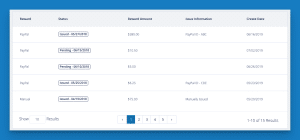
Be sure to choose an affiliate software with lots of relevant integrations, so it seamlessly passes information to and from other marketing tools you already use. Also, select an affiliate software that lets you customize your program how you’d like, offers features to keep affiliates engaged, and provides stellar customer support.
And make sure that the software doesn’t operate like an affiliate network. After all, you don’t want to sacrifice control over your affiliate data and relationships – this control is why you want affiliate software in the first place.
Why choose Referral Rock affiliate software?
Referral Rock affiliate software lets you take full control of your affiliate program, with all the tools, data, and support you need for success:
- Set up your program and launch in a snap, thanks to prebuilt templates, best practices, and expert guidance from an onboarding specialist.
- Select any commission structure you want (we support tiered, recurring, and limited-time commissions)
- Customize your affiliate experience with our easy program builder
- Seamlessly integrate Referral Rock with your existing tools and processes, including your CRM.
- Keep affiliates engaged by giving them full visibility on their progress via a dedicated portal, and by sending monthly emails with updates on their progress.
- Track affiliates’ sales through detailed metrics, so you always know your ROI and know where to focus for program optimization
- Manage affiliates on your terms, and automate key processes, without being held back by a marketplace
Learn more about how Referral Rock can help you give your affiliates the best experience >
Start an affiliate program that works for your business
Now that you know the steps needed for successful affiliate marketing, you’re ready to start an affiliate marketing program of your own. First, check the competitive landscape. Then, design a program that sets your brand apart in the affiliate’s eyes, with an attractive commission.
And of course, find and recruit the right affiliates, who will help your brand reach sales goals.
Affiliate marketing software is essential if you plan to run an affiliate program with your own network. It allows you to run a low-cost program where you keep full control of your affiliate marketing strategy. In the market for this type of software? See how Referral Rock can help >
Looking for more affiliate marketing strategies and tips specific to your industry? Check out the guide that’s right for your business, and learn how to create an affiliate program that works best for your niche:

